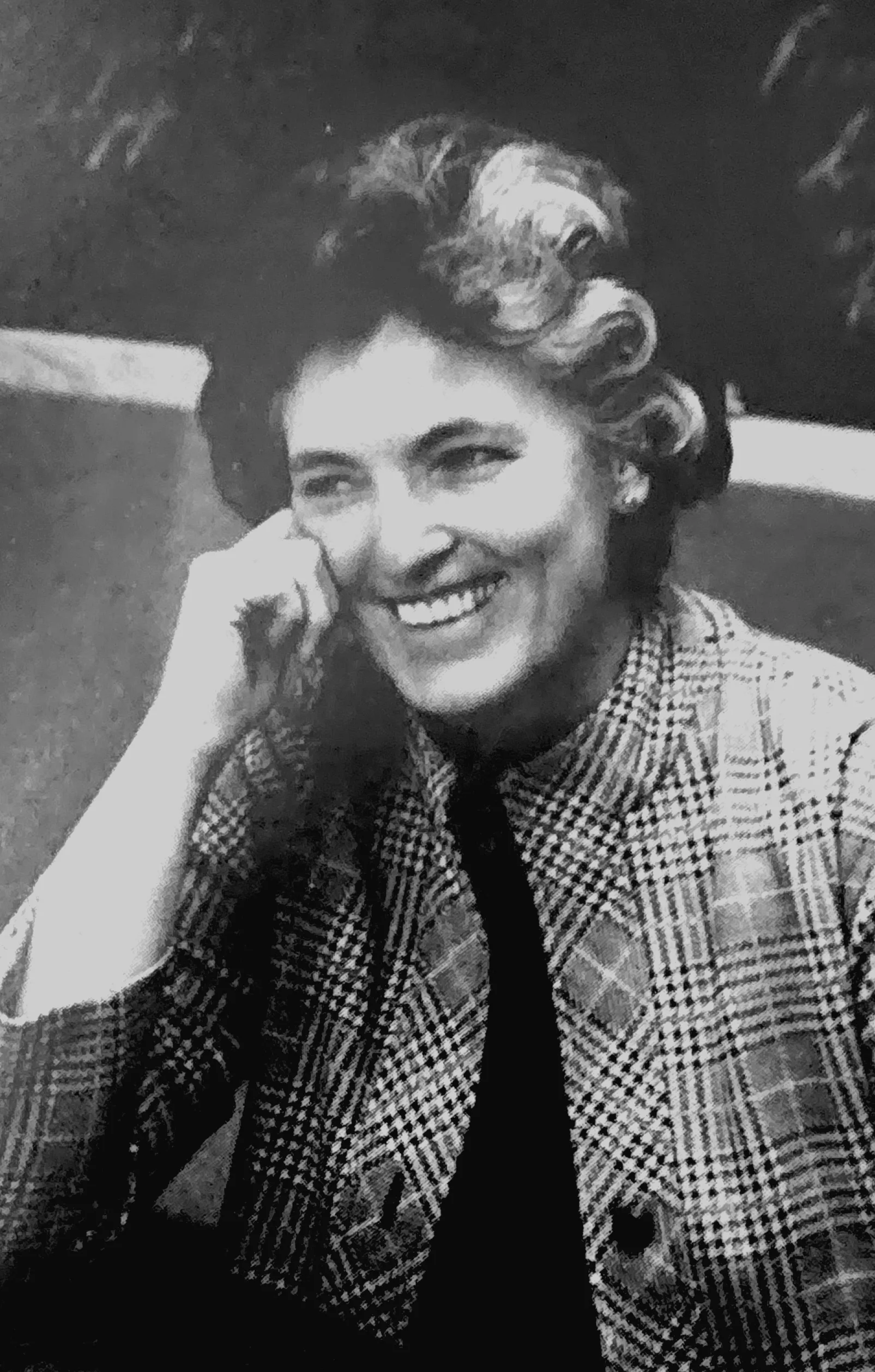
Remembering Dr. Joan Kinnaird
Eulogy for Dr. Joan Kennedy Kinnaird by her son Stephen Kinnaird
 We encounter life as much as life encounters us. Three qualities of my mother, Joan Kinnaird, shaped her encounter with life. The first is a loving joyfulness in all aspects of her life. The second is her subtlety of mind. The third is her rectitude, by which I mean her commitment to doing things the right way, and in particular treating people the right way. These three traits produced a life of uncommon grace.
We encounter life as much as life encounters us. Three qualities of my mother, Joan Kinnaird, shaped her encounter with life. The first is a loving joyfulness in all aspects of her life. The second is her subtlety of mind. The third is her rectitude, by which I mean her commitment to doing things the right way, and in particular treating people the right way. These three traits produced a life of uncommon grace.
My mom was born in 1928, and grew up in the mill town of Fall River, Massachusetts. Her family was not poor but met with adversity. Her father died young, and her mother and aunt joined forces to support the household. Life revolved around the Irish Catholic parish of Saint Patrick’s.
My mother used to say that three persons truly taught her in life. One was Mrs. McGuire of the Saint Patrick’s parish school, who instilled in her a love of poetry and spotted Mom’s talent. Mrs. McGuire encouraged her to aspire beyond the typical horizons of a Fall River girl. As a result, at 16 she travelled to Poughkeepsie, New York on a scholarship to Vassar College.
My favorite anecdote of her time at Vassar demonstrates her trait of rectitude, in the academic sphere. She had signed up for an English history class by Mildred Campbell, a prominent social historian and the second person who, in my mother’s view, truly taught her. Professor Campbell wanted her charges to grapple with original sources, and so the first assignment was to analyze Bracton’s 13th century work on the Laws and Customs of England. My mother dutifully descended to the basement of Vassar’s rare book library … and spent the weekend in tears. She was clearly overmatched. Translating Bracton from Latin and then analyzing it was too difficult and took forever. She could not keep up with the girls from the fine Eastern schools who clearly had the polished Latin skills to breeze through the assignment. They were not toiling in the bowels of the rare book library. She would have to head back to Fall River where she belonged. She finished her assignment late Sunday, and returned to the dormitory, despondent. Well, the next day Mildred Campbell reviewed the class’s submissions and her eyes grew wide. She burst across the hall to the office of Evalyn Clark, the other grand dame of the Vassar history department, and exclaimed, “Evalyn, we have a scholar in the freshman class!” You see, the assignment was to analyze a translation of Bracton, not to translate Bracton. So you may say, well, Mom was just careless about the assignment. But Mom fell into error because she assumed the assignment was to be done the right way, and she spared no effort to do it that way.
That assignment, demonstrating astute analysis and heroic effort, marked Mom as a star from the beginning of her freshman year. She went on to 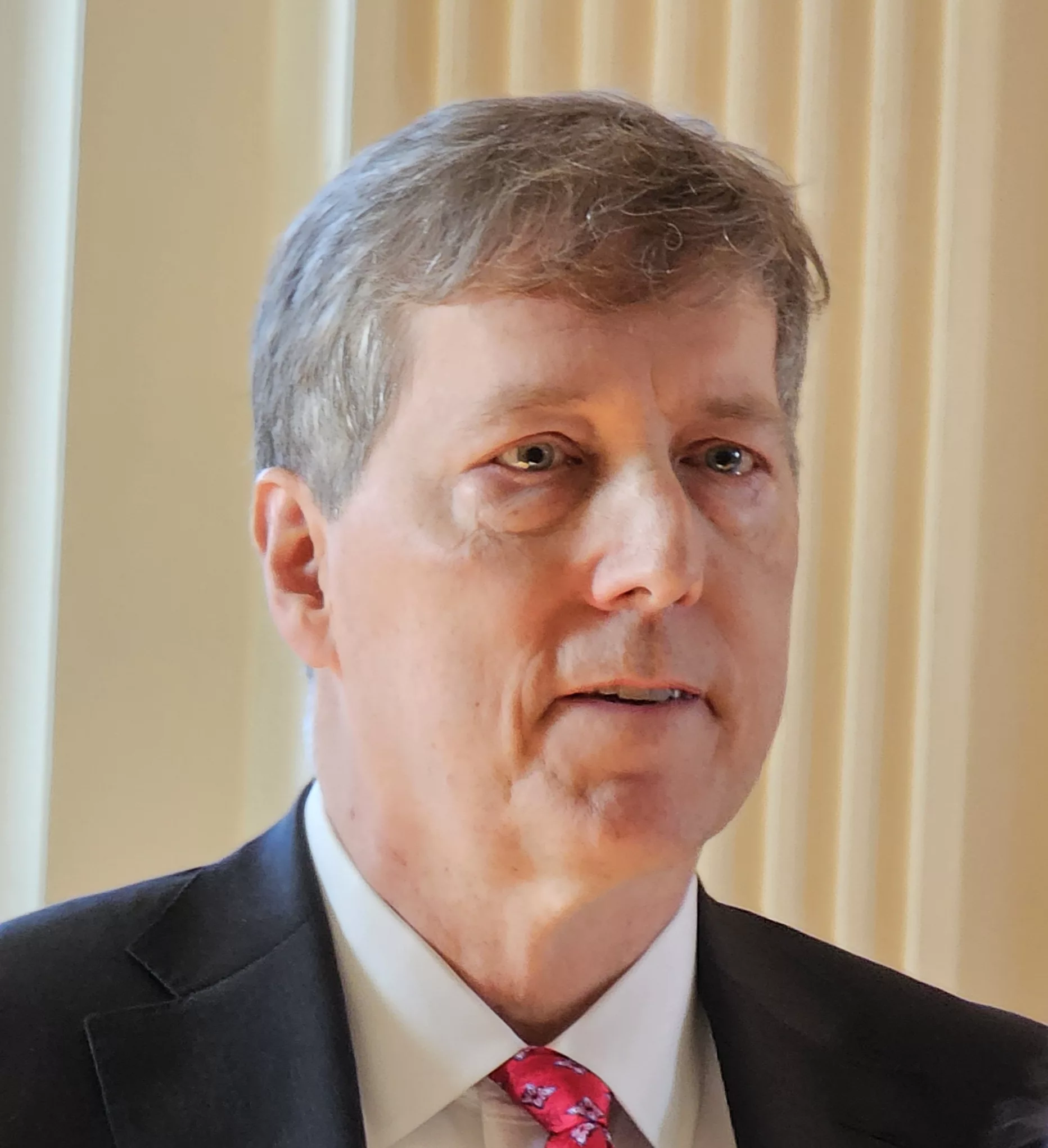 graduate first in her class at Vassar, summa cum laude. She proceeded to graduate studies in history at Yale, which in the 1950’s did not admit female undergraduates, but did deign to train the future faculty of women’s colleges. Vassar was so eager to keep Mom that it appointed her to its faculty after she earned her masters at the ripe age of 23 and was still working on her doctorate. Mom felt queasy teaching students of her own age, with scarcely more training than they had. But she found a way.
graduate first in her class at Vassar, summa cum laude. She proceeded to graduate studies in history at Yale, which in the 1950’s did not admit female undergraduates, but did deign to train the future faculty of women’s colleges. Vassar was so eager to keep Mom that it appointed her to its faculty after she earned her masters at the ripe age of 23 and was still working on her doctorate. Mom felt queasy teaching students of her own age, with scarcely more training than they had. But she found a way.
(Photo right: Stephen Kinnaird giving the eulogy for his mother.)
At Yale, she studied history with William Dunham, the third person who truly taught her. She again rose to the top. The faculty called her in to tell her that she and a male counterpart had equally earned the top fellowship, but the faculty had decided to give it to him. The reason was he had a family to support, whereas she was certain to be married in short order and would not need the money. This being the mid 1950’s, Mom was not outraged, but instead flattered they were so certain of her marriage prospects.
Mom was an adventurer. She loved travel; she had a Fulbright to the London School of Economics to study the role of the king in English constitutional law. After she earned her Ph.D., Mom deferred a professorship at Vassar to live in Turkey for a year teaching at a girl’s school for the cream of Turkish society.
She then returned to Vassar. In a short span, she turned down multiple marriage proposals—the Yale faculty were right on that score—before finding her match in an erudite Vassar English professor, my father John Kinnaird, whom she married at the then-extreme age of 32. My brother John and I arrived in quick succession. And after the blur of our preschool years, and my father’s acceptance of a position at the University of Maryland, she came here to Trinity in 1968, which was such a perfect fit for her. We will hear shortly from Mary Lynn Rampolla and Susan Farnsworth about that dimension of her life.
That was the point at which I began to have more conscious observations of Mom, and so I return now to the three traits I mentioned at the outset.
Mom had such a remarkable capacity to feel joy and bring joy. Her joy was infectious, with her warmth and ready laugh. She found joy foremost in family and friends, but also in ideas, culture, and nature. Our family travelled to Tuscany when she was in her 80’s. As our rental car turned the corner to a vista of an Italian hilltop town, she exclaimed, “LOOK AT THAT!” Everyone’s heart leapt with hers. She loved poetry, which she recited from memory all her life, even after her stroke. Artistic works were for her, in the words of her beloved poet William Butler Yeats, the “singing masters” of the soul that teach us to clap and “louder sing for every tatter in our mortal dress.” She clapped and sang vigorously until the end.
She had a dynamic mind that generated ideas; she delighted in discerning the truths of human life and the springs of human action, and most of all in exchanging ideas with others. For her, knowledge was communal.
But it was her rectitude that completed the triangle. One source of that was her Catholic faith, her sense of Christian humility and duty. But she also had a concept, which she borrowed from Edmund Burke, of the natural aristocrat. Burke’s was a political notion that men of merit and not class should rule the nation. Mom converted the political to the personal. She conceived of natural aristocrats—and I quote from a eulogy she wrote for a colleague who earned that honor—as persons “whose superior qualities set them apart without separating them from others” and who “personified taste, refinement, an instinctive courtesy, the principled life—and all without artifice or pretension.” That sums my mother up rather well. And it accounts for why people from all walks of life loved her.
To be my mother’s son is an indescribable blessing. So too to be her daughter-in-law, her grandchild, her nephew or niece. Because of her unique traits, there was such intentionality, so much thought and care and grace, in her love of each of us.
My mother rejoiced; she understood; she lived the right way. We are all richer for having shared in her life.
 Joan…. A Remembrance by John (Joan’s son John Kinnaird, photo left)
Joan…. A Remembrance by John (Joan’s son John Kinnaird, photo left)
We remember Joan’s long life in tiny glimpses In little facets on a turning crystal …just moments that have meaning to us now. Moments that seem to show us something about Joan…
Memories arrive, spiraling toward us as autumn leaves from mist.
One memory has her wrapped in a Scottish tartan, in her grandmother’s rocking chair, with a resting dog by her slippered feet, absorbing the glow of the family hearth She was in reverie, thinking of her ancestors keeping warm on the cold Massachusetts frontier…
If memory serves, my aunt used to say that the best thing that ever happened to her brother, my father Jack, was definitely Joan ……and many great things had happened for him.
I remember a book of Emily Dickinson poems falling into her lap as she nodded off into a nap in the patio’s springtime sun. Overhead, roses were floating on birdsong breezes.
I have a memory of Joan’s triumphant return from Paris with a big suitcase, stuffed with perfumed and sugar sprinkled gifts for friends but strangely….l don’t remember much of anything for her.
One memory I have of Joan was her busily wrapping presents with festive paper.She would produce a colorfully wrapped bedtime book for every child she could meet.
Another memory of Joan was a house filled with columns of dog-eared European history textbooks stacked on every available surface and hidden under chairs and tables as well. It seemed these columns were supporting the house, and indeed they were.
Remember her letting out an exhilarated gasp which was drowned out by the Alaskan wind as the great gray whale breached high before the snow caps, showering diamond drops all around the boat.
I remember brimming bags of wine,cheese and baguettes from a French market 30 miles away, Nothing else would do… friends were coming…
Remember how she used to whisper prayers beneath her shawl . They were prayers for her beloved Pope Francis and his continued health, as she watched him beam across the eternal city.
David Byrne probably doesn’t remember, but he had a bewildered look as he looked down into the second row of the concert to see an 85-year-old woman, excitedly singing along with his Talking Heads songs. It’s not easy to bewilder David Byrne!
I can remember…. how a child’s hand pushed open her pine wreathed door to time tunnel back to a Victorian Christmas replete with baking gingerbread and a crackling fireplace.
A memory from Mexico, Joan stood in the dappled sun beneath the palms. Her eyes were wide and smiling again. Before her the ornate Mayan Temple of the Magician, towering in the bright blue heat of the Yucatan sky. Though the recent loss of my father still ached there was still magic in this world and she and her young sons had come to find it.
We remember Joan’s long life in glimpses of a story on the pages of an open book she forgot on the garden table. The wind turns the cottony soft pages ….
I remember her mittened hand, clapping a scream overcoming her fear so she could feast her eyes on the Alps below the Chamonix cable car. Some things just have to be experienced.
One might remember that she had labored for years and memorized reams of poems and prose by all those clever Irish wordsmiths lest she forget to bring a book and be in need of a bit of wit.
Joan is remembered for her vivid daydreams. She could picture Lorenzo De Medici resplendent in a red velvet cloak appearing on the high marble balcony surveying his civilization. Down below, the Italian piazza was mobbed with sticky gelato licking hordes that were oblivious to his presence.
Often, I recall, I would snuff out the midnight oil of her bedside lamp and gently remove her reading glasses. She had read her new book into the wee hours, intellectual satisfaction was more important than sleep to Joan.
Do I remember the poor postal worker, struggling up the brick sidewalk, arms laden with piles of charity outreach envelopes
Those charities work desperately to find generous souls like Joan.
Remember how her little car crossed the empty parking lots of the midnight airport to pick you up when your plane was late?
It was a car laden with refreshing snacks and drink with an angel at the wheel. it was an ambulance come to rescue the jet lagged.
In a memory from her youth, a foul tempered Egyptian camel lunged and grunted at Joan but she would not be intimidated. She had come to trek the pharaoh’s trail ….and would not be deterred.
Memory has it that many young girls left their beloved professor Joan’s office with eyes gazing upward and a slight smile. It was decided, they, too, would study abroad and go on to teach and inspire others.
I remember Joan sitting on the beach, looking through the circling gulls over rows of tiny whitecaps toward a distant ship. I knew what she was thinking of… It was her great grandfather sailing further out onto the main in his whaling ship.
These random memories coming to mind offer insight into a long life, well lived. I remember her and others will remember her differently. Joan was many things to many people …. A wife, mother, grandmother, teacher, mentor, scholar and…. of course,… a friend…
Thank you for joining us on this memorable day
Pat McGuire’s Blog Reflection on Dr. Kinnaird:
So compelling an influence on me was Dr. Joan Kinnaird, professor of History at Trinity, that shortly after I became Trinity’s president in 1989, she was able to convince me (her former student) to dress up like a medieval princess and sit high on a dais in Alumnae Hall eating roasted chicken with my hands as part of the Medieval Festival that she organized along with other History faculty and students. Making history come alive with a large imagination and keen perspective on the customs, dress, music, food and sociology of each era we studied was Dr Kinnaird’s magnetic pedagogy, a style that kept students from all disciplines re-enrolling in her very popular courses.
Dr. Kinnaird, who died at the end of September at age 91, was one of Trinity’s most compelling faculty members, deeply devoted to the essential purpose of the liberal arts but always open to learning new pathways for intellectual engagement. (We will have a memorial service for Dr. Kinnaird on Saturday, November 11 at 2 pm in the second floor chapel of Main Hall.)
I first met — or rather, observed — Dr. Kinnaird as she dashed into our 17th Century history class sometime in 1971. She had a large briefcase/tote bag that she rummaged through, at last extracting a slip of paper on which she had scribbled an epitaph from a tombstone in a cemetery she had visited in France over the summer. I confess I cannot remember the epitaph, itself, but what astonished me as an 18-year-old sophomore was the idea that we could learn history by visiting cemeteries and reading tombstones.
All of my prior encounters with history were dry as dust, textbooks heavy with dates and wars and men wielding power over helpless serfs. Women were mostly absent, except as hapless victims or silent partners. Suddenly, here was a teacher who blew that dust away, who pulled back the curtain on how people actually lived and talked and worked and thought about life in other centuries in places that became not-so-strange through the lens of her lessons; here was a woman teaching about the Women of History — I had never thought much about women as historical protagonists before taking Dr. Kinnaird’s class, and suddenly I began to realize that half of the human population was left out of all that I had previously learned.
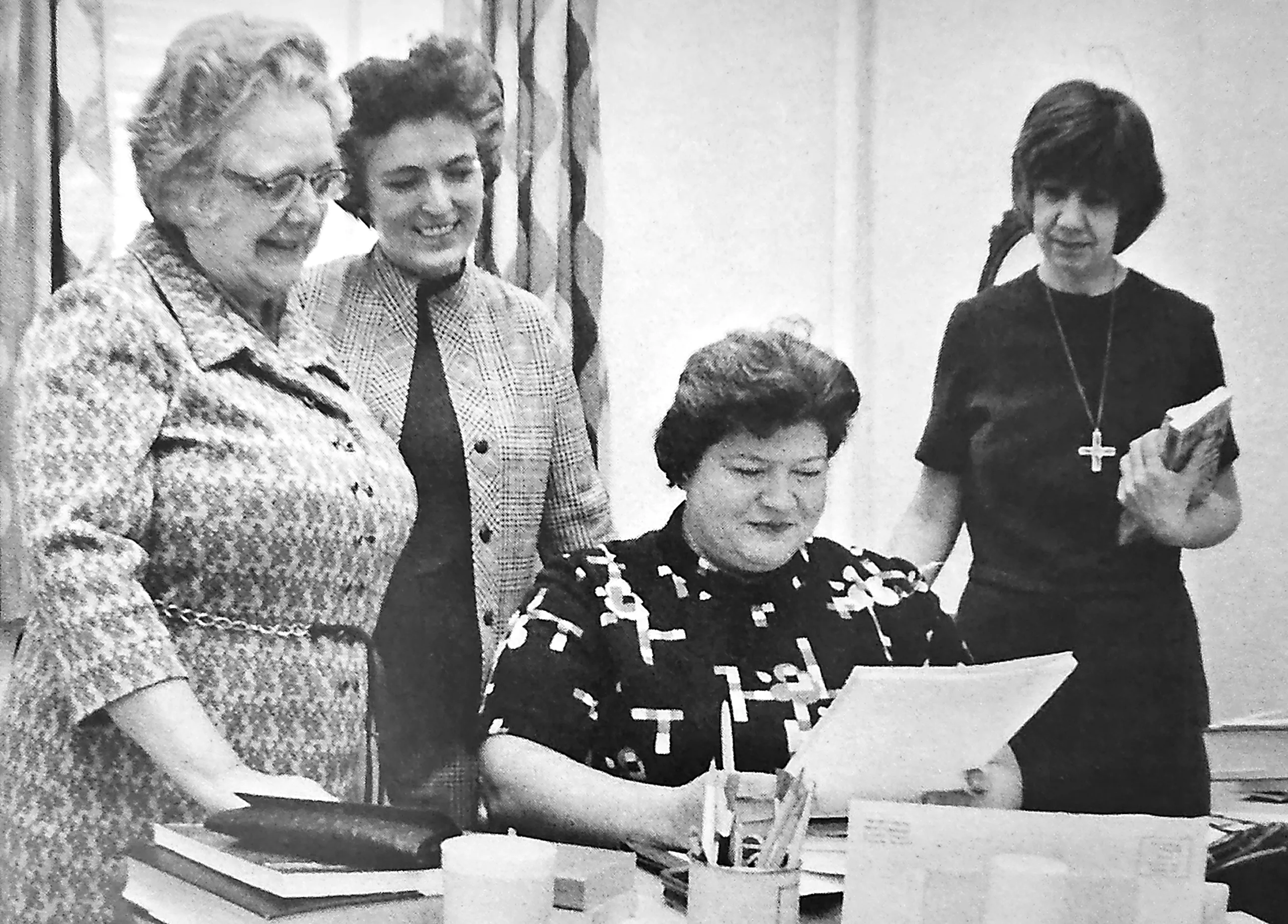
(Powerhouse Trinity History Faculty in the 1975 Trinilogue:
From Left: Sr. Mary Lawlor, SND; Dr. Joan Kinnaird; Dr. Jean Willke (seated); and Sr. Mary Hayes, SND)
Joan Kinnaird was, in so many ways, the ultimate “Renaissance Woman,” so learned across so many disciplines, an avid reader across an astonishing range of literature, a keen observer of human conditions and foibles and fashions through the ages. We Trinity Women were somewhat envious of the intellectual cool emanating from this Vassar Woman with her Yale Ph.D. We enjoyed her company and always wanted to rise to her high expectations — we strived to be as learned, as precise, as insightful as she, even if we often fell short of that lofty goal.
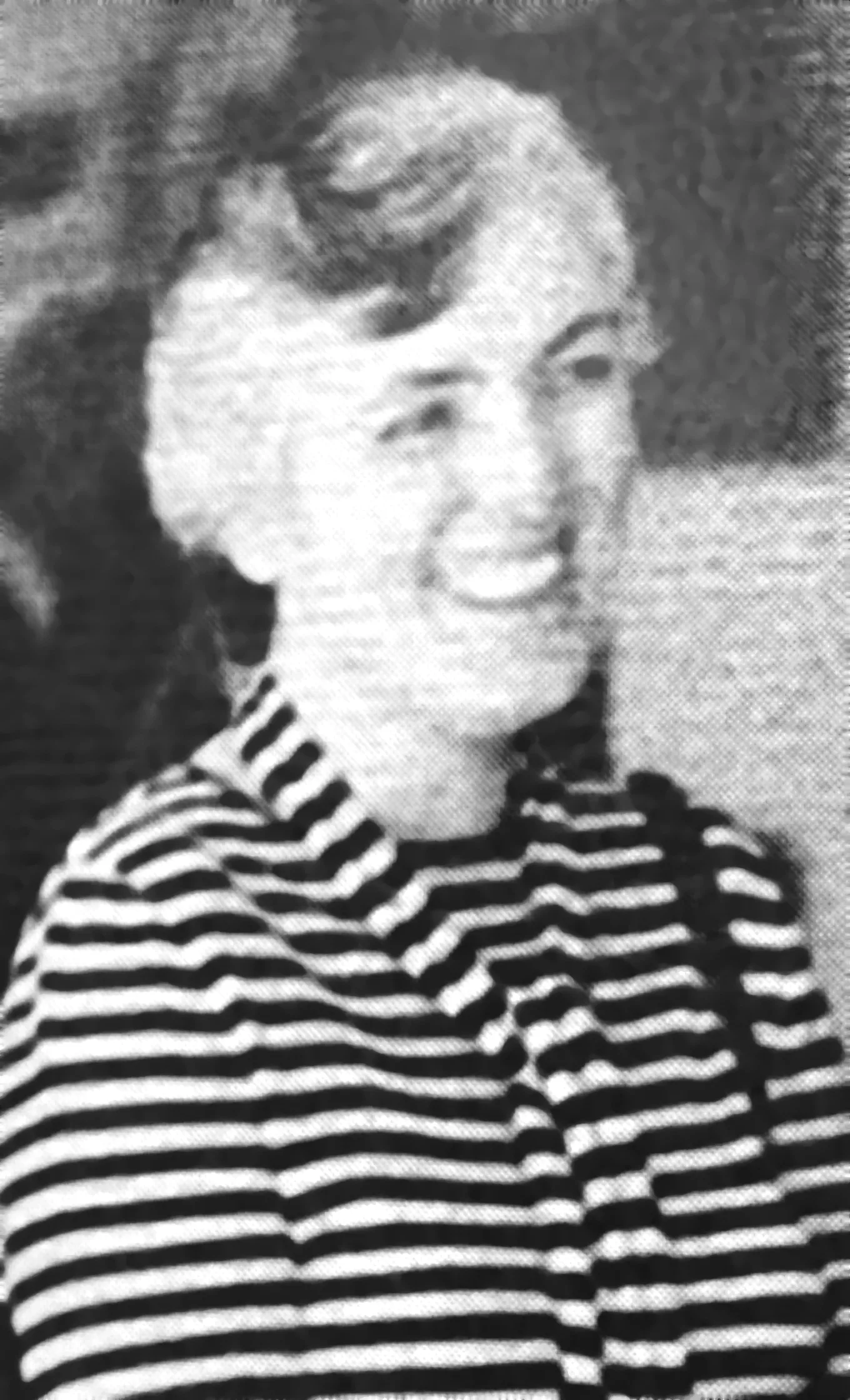 My last class with Dr. Kinnaird was in April of my senior year, sitting in the first floor lounge of Kerby Hall with sunlight filtering through the young green leaves of the spring trees outside, music wafting through the room as we sipped some white wine out of dixie cups (yes, times and rules were different then in the early 1970’s!) while discussing the rebuilding of Europe after World War II in her European Intellectual History class. We had spent the semester studying the devolution of civilization in Germany from WWI to WWII along with the horrors of the Holocaust; we learned about the heroism amid the inhumanity through listening to music composed and played by prisoners at Auschwitz, watching movies like The Grand Illusion and reading the literature that evoked Europe’s slide into moral and political chaos. I was a Political Science major, but I found her courses essential to my understanding of political movements and revolutions. In recent years, I have thought of that class often as I have observed America’s struggle with demagoguery and rising authoritarianism. The cycles of history are relentless.
My last class with Dr. Kinnaird was in April of my senior year, sitting in the first floor lounge of Kerby Hall with sunlight filtering through the young green leaves of the spring trees outside, music wafting through the room as we sipped some white wine out of dixie cups (yes, times and rules were different then in the early 1970’s!) while discussing the rebuilding of Europe after World War II in her European Intellectual History class. We had spent the semester studying the devolution of civilization in Germany from WWI to WWII along with the horrors of the Holocaust; we learned about the heroism amid the inhumanity through listening to music composed and played by prisoners at Auschwitz, watching movies like The Grand Illusion and reading the literature that evoked Europe’s slide into moral and political chaos. I was a Political Science major, but I found her courses essential to my understanding of political movements and revolutions. In recent years, I have thought of that class often as I have observed America’s struggle with demagoguery and rising authoritarianism. The cycles of history are relentless.
Joining Trinity’s History faculty in 1968, Dr. Kinnaird taught an astonishing range of courses over the years, from Medieval Foundations of Western Civilization, to Renaissance and Reformation, to 17th Century, Enlightenment and French Revolution, Feminist History, and her famous two-course sequence in European Intellectual History. She was an avid traveler, leading alumnae trips to France and England. On campus she organized events such as La Belle Epoch and the Medieval Festival. She was an advisor to hundreds of students through the years, and a constant presence at student events.
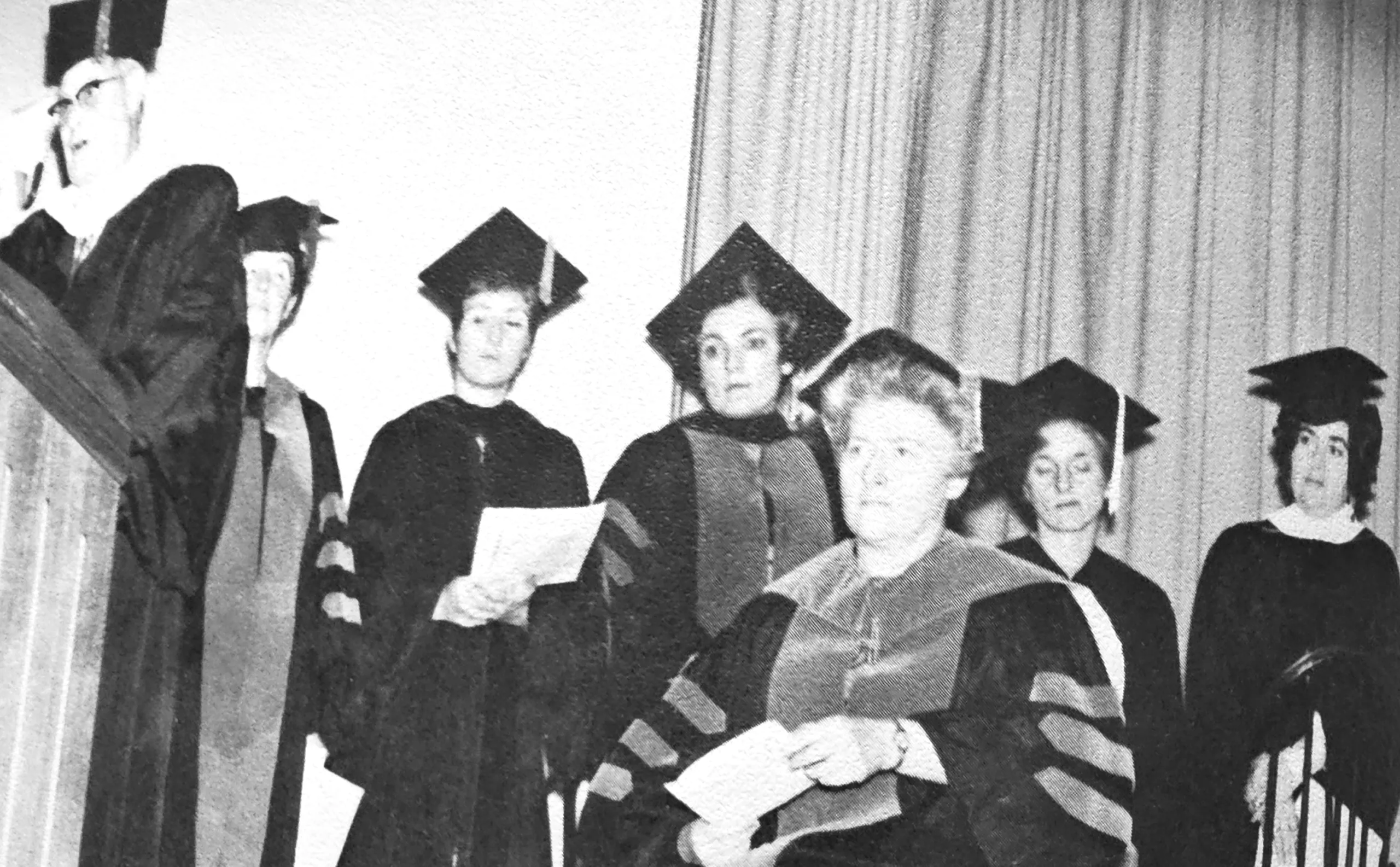
One of Dr. Kinnaird’s proudest achievements was securing Trinity’s admission into Phi Beta Kappa in 1971, at that time only the second Catholic women’s college ever admitted to that prestigious honor society. The photo above shows Dr. Kinnaird in the middle (standing) with President Sr. Margaret Claydon (seated) and other members of the new Epsilon Chapter of Phi Beta Kappa at the inaugural PBK ceremony at Trinity.
Never tiring of intellectual engagement and exploration, after her retirement in 1994 Dr. Kinnaird stayed active in many academic endeavors including taking courses at the University of Maryland where she quickly bridged the age gap with traditional students through her charismatic love of learning.
Her husband John was a Professor of English at the University of Maryland. Two sons, John and Stephen, survive her. We send them our deepest condolences along with our fondest memories of a wonderful teacher, colleague and friend.
An amazing woman. Great teacher and mentor. Every conversation with her was a learning experience. Looking back at Trinity years, she is integral to the memories.
Dr Kinnaird has the most incredible impact on my experience at Trinity. Everyone has someone who played a pivotal role in their education and for me that was Dr. Kinnaird. Hands down. She was the was the most lovely, incredible person who came into my life as a freshman at Trinity College DC. She was not only a brilliant, passionate educator but took me under her wing and was a constant advocate. I will never forget her encouragement and kindness, not only in my studies but in finding financial support when times were tough. I only just see in her obituary that she was also also raised by a single mother so I’m guessing she was moved by my situation. I credit her with my ability to find a way to stay in the place I loved and what I became from there. I will never forget her impact on my life.
Beautifully written remembrance. One small detail: Joan Kinnaird was 95 upon her passing. She is greatly missed. Thank you for these wonderful stories of her life.
A REMEMBRANCE OF PROFESSOR JOAN KINNAIRD
It is difficult to describe the sadness and sense of loss I felt upon hearing of the death of Professor Joan Kinnaird. I have never encountered a kinder, more sensitive, empathetic, knowledgeable, and modest person.
Joan possessed positive and unique qualities as a teacher, scholar, humanist, and woman of faith. She taught by example in all matters, reflecting a quiet and selfless devotion to her students, colleagues, friends, and family.
I first met Joan in the fall of 1983 when I arrived at Trinity College as a part-time lecturer in art history. The chair of the Art Department was Liliana Gramberg, an accomplished artist and a remarkable teacher. I was soon ushered into the special educational environment that existed at Trinity between and among the faculty and students devoted to the study of the liberal arts. My time at Trinity would become one of the most important and formative periods in my personal and professional life, in no small measure due to my friendship with Joan Kinnaird.
Because of the many ties between the female faculty members at Trinity and the University of Maryland where I was a Ph.D. candidate, I soon realized that there were a number of husband and wife teams whose careers had unfolded at each school. This fact was in part how I came to meet many of the gifted professors at Trinity including Liliana Gramberg, Eda Levitine, Anna Lynch, and Joan Kinnaird. Added to that list as a special friend and colleague was also Sister Maura Prendergast, SND. All these faculty women were beloved and respected by Trinity students and teachers alike.
I can still recall my first encounter with Joan Kinnaird. I was teaching an art history class in the evenings in the lower classroom of the library. As the class ended, I gathered my notes and rolled the cart with the slide projectors out into the hall. A distinguished looking woman approached me and introduced herself as Joan Kinnaird, a Trinity professor of History. She was soft-spoken and elegant. We exchanged pleasantries when Joan got to the heart of the matter. She had heard of my arrival and knew something of my background. She was interested in knowing if I would consider teaching in a summer study program in Italy that she had organized for Trinity students. It was to be a team-taught program in the study of Italian Renaissance history, literature, and art history. I expressed my interest and Joan invited me to her house for lunch to meet the third professor she had spoken to about teaching the literature component, Sister Maura Prendergast. Thus began my forty year friendships with these two great ladies of Trinity College.
After my time at Trinity, and
throughout my subsequent academic career at various universities, I came to rely upon Joan’s career advice, moral support, and warm encouragement and comfort. She guided me through many of the pitfalls and setbacks of an academic life and career. It was an unexpected gift when I returned to D.C. to accept a position at the National Gallery of Art and we were once again able to spend time together.
Joan Kinnaird’s life and career are a moving testament to her deeply felt Catholic faith, her commitment to teaching, knowledge, and learning, and her abundant capacity for human kindness. A more extraordinary woman I have never known.
We are all aware of Joan Kinnaird’s beauty and grace and of her sterling accomplishments: As a summa cum laude student and valedictorian at Vassar, as a fellowship recipient, as a teacher, as a person who brought a chapter of Phi Beta Kappa to Trinity, and many others.
I myself would like to pay tribute to Joan as being the consummate friend. As of this year, I will have known Joan Kinnaird for forty years. In 2983 I became her colleague at Trinity, but soon we became much more than that. Along with Eda Levitine we comprised a sort of latter day version of the Three Musketeers. We were from highly varied backgrounds and of different ages, but we were intellectual soul mates. There was much to talk about during lunches in the faculty lounge, where the repartee was always stimulating. We always learned from each other. With complementary backgrounds in the liberal arts, we team-taught courses from time to time, and we shared many lively discussions about history, art history, and literature. We were often at dinner in each other’s homes and got to know and to value each other’s spouses and children (although Joan’s spouse had died before I came home Trinity). We attended art exhibitions and conferences together.
Soon, we began to take trips with one another: To the Hudson Valley, to Frank Lloyd Wright’s Falling Water and the sights in Philadelphia, and to various other places on the East Coast. On several occasions (and once with Sister Maura) took students and alumnae on study tours to Italy and England. Things didn’t always go precisely as planned. On an alumnae tour to England, we arrived to find that our Washington travel agent had failed to reserve a bus for us. Through some fancy rushed maneuvering, we were able to secure transport, ending up with a very pleasant and accommodating, if inept, driver. He wasn’t good with maps. As he drove around Norfolk heading towards our first night’s accommodations, we noticed that we kept passing through a small village called Great Snoring. (Luckily, our tour group didn’t seem to notice this circular routing since most of them were sleeping off the overnight flight from the States and snoring themselves.). Joan always claimed she was bad with maps, but on that trip we managed to find a driver whose sense of direction was more iffy than hers. We did eventually get to our hotel, if much later than anticipated.
Several times Joan and Eda and I rented a car and traveled together in Europe on our own. One particularly memorable moment came as we were crossing the Italian Alps into Austria. We got out of the car at the pass, opened a bottle of champagne, and drank it sitting together on a glacier. Another memorable trip was to Spain. Joan and Eda had planned an alumnae trip along the Pilgrimage Route in Spain. The trip didn’t get fully subscribed so had to be cancelled. However, we three decided to do the trip together anyway. Luckily, we managed to convince my husband Mike to come along as our driver, baggage carrier, and all around personal assistant, which facilitated things enormously.
I could go on and on recounting these precious memories of my dear friend and colleague. The most recent and, sadly, the last time I was with her was on her birthday this year in May. Her son John had arranged for a birthday cake, and when the candles were lighted, Joan’s eyes sparkled. We spent a lovely afternoon sitting in the sun on the porch. Joan was smiling and radiant. Her conversation was engaging, if a bit halting. She was as gracious as ever. In looking back over the past forty years, many of my most treasured memories center around Joan. As a friend and as an intellectual role model, Joan continually beckoned me to explore new areas of knowledge. She shone a light upon my life that will continue to shine.
Joan is remembered in grateful prayer by her SND friends here at Mt Notre Dame in Ohio — as a treasured colleague, friend and fellow laborer in the Lord’s vineyard!
admission into Phi Beta Kappa
My favorite anecdote of her time at Vassar demonstrates her trait of rectitude its good
Beautifully written remembrance.